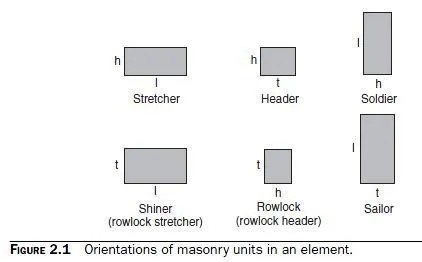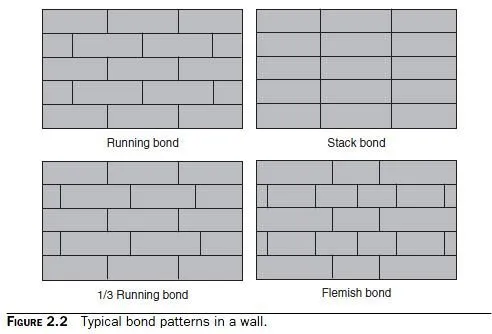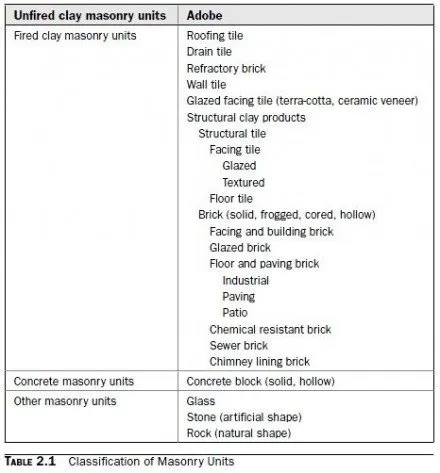Masonry can be used in a wide variety of architectural applications, including
Walls (bearing, shear, structural, decorative, bas-relief, mosaic)
Arches, domes, and vaults
Beams and columns
Masonry, while often simple and elegant in form, can be complex in behavior. Also, unlike concrete, it cannot be ordered by the cubic yard. To understand its behavior, and to be able to specify masonry correctly, we must examine each of its basic components: units; mortar; grout; and accessory materials.
Immediately below, each component (and related concepts) is discussed briefly. In later sections, more details are provided.
Preliminary Discussion of Masonry Units
Masonry units, as noted in Table 2.1, can be classified in a wide variety of ways.
In this book, we shall emphasize the behavior and use of structural masonry units, of fired clay or of concrete.
Preliminary Discussion of Masonry Mortar
In the United States, three basic cementitious systems are used for mortar: cement-lime mortar; masonry-cement mortar; and mortar-cement mortar. The first two are widely used, the third has been recently introduced.
Cement-lime mortar is made from different proportions of portland cement or other cements, hydrated masons lime, and masonry sand, mixed with water. It can be batched by hand on-site using material from bags, or batched automatically on-site using material from silos.
Masonry-cement mortar is made from different proportions of masonry cement and sand, mixed with water. It may also contain additional portland cement or other cements. Masonry-cement formulations and manufacturing processes are manufacturer-specific. Ingredients are not required to be identified, and usually are not. Masonry cement generally consists of portland cement, pozzolanic cement, or slag cement, plasticizing additives, air-entraining additives, water-retention additives, and finely ground limestone (added primarily as a filler, but with some plasticizing and cementitious effect).
Mortar-cement mortar is made from different proportions of mortar cement and sand, mixed with water. It may also contain additional portland cement or other cements. Mortar cement formulations and manufacturing processes are manufacturer-specific. Ingredients are not required to be identified, and usually are not. Mortar cement generally consists of portland cement, pozzolanic cement, or slag cement, plasticizing additives, air-entraining additives, water-retention additives, and finely ground limestone (added primarily as a filler, but with some plasticizing and cementitious effect). It differs from masonry cement in that it is formulated specifically for tensile bond strength comparable to that of cement-lime mortar.
Preliminary Discussion of Masonry Grout
Grout is fluid concrete, usually with pea-gravel aggregate. It can be used to fill some or all cells in hollow units, or between wythes.
Preliminary Discussion of Masonry Accessory Materials
Masonry accessory materials include reinforcement, connectors, sealants, flashing, coatings, and vapor barriers.
Connectors (of galvanized or stainless steel) connect a masonry wall to another wall, or a masonry wall to a frame, or a masonry wall to something else.
Sealants are used in expansion joints (clay masonry), control joints (concrete masonry), and construction joints.
Flashing is a flexible waterproof membrane used for drainage walls.
Coatings include paints and clear water-repellent coatings.
Moisture barriers and vapor barriers are used as parts of wall systems to retard the passage of water in liquid form and vapor form, respectively.
Preliminary Discussion of Masonry Dimensions
Masonry unit dimensions are typically described in terms of thickness × height × length. Typically, the length is the largest dimension, the thickness is next, and the height is the smallest dimension.
For example, a typical clay masonry unit has dimensions of 4 × 2.67 × 8 in. These are nominal dimensions, that is, the distances occupied by the unit plus one-half a joint width on each side. Joints are normally 3/8-in.
thick. The specified dimensions of the unit themselves are smaller; in this case, 3-5/8 × 2-1/4 × 7-5/8 in. The actual dimensions are the measured size, and should fall within the specified dimensions, plus or minus the tolerance permitted by the governing material specification.
The sides of a masonry unit are often designated in literature by special names
The bed is the side formed by thickness × length
The face is the side formed by height × length
The head is the side formed by thickness × height
Orientation of Masonry Units in an Element
Masonry units can be placed in a wall or other element in many orientations, as shown in Fig. 2.1 (looking perpendicular to the plane of the element). The stretcher orientation is the most common, and the soldier orientation is often used above or below wall openings.
Bond Patterns
Masonry units can be placed in a wall or other element in many bond patterns (arrangements), as shown in Fig. 2.2 (again, looking perpendicular to the plane of the element). In this figure, the horizontal joints are referred to as bed joints, and the vertical joints are referred to head joints.


In all the bond patterns of this figure, the bed joints are continuous along every course (level) of masonry.
In running bond, the head joints align in alternate courses, and are aligned with the middle of the units in adjacent courses.
In stack bond, the head joints align in adjacent courses.
In 1/3 running bond, the head joints align in alternate courses, and are aligned one-third of the way along the units in adjacent courses.
In Flemish bond, units of two different lengths are used. Many other bond patterns are possible.
Types of Walls
Masonry is most commonly used in walls. Masonry walls can be classified in many different ways. For now, we shall classify masonry walls according to how they resist water penetration. Using this criterion, masonry walls can be classified as barrier walls or drainage walls. Examples of each type are shown in Fig. 2.3.
Barrier walls resist water penetration primarily by virtue of their thickness. They may have coatings. They may be single-wythe (one thickness of masonry), or multiwythe. Multiwythe barrier walls can have the wythes connected by bonded headers [masonry units placed in header orientation, or by a filled collar joint (space between wythes)].
Drainage walls resist water penetration by a combination of thickness and drainage details. Drainage walls may also have coatings. Drainage details include an airspace (at least 2 in. wide), flashing, and weepholes. Drainage walls can be single-wythe (veneer over steel studs) or multiwythe (veneer over masonry backup). The latter are often also called cavity walls.
Overview of How Masonry Is Specified
To further discuss how masonry is specified, it is necessary to recognize the following: 1. Unlike the steel or concrete industries, individual segments of the masonry industry rarely produce a finished masonry assembly.
2. It is therefore necessary to specify precisely each component of masonry (units, mortar, grout, accessory materials). In the United States, this is done through standard specifications, methods of sampling and testing, test methods, and practices. Most applicable standards are developed by the American Society for Testing and Materials (ASTM). A few are produced by model code organizations (e.g., the International Code Council). We will focus on ASTM standards, using them as a frame of reference for the specification of masonry elements.
